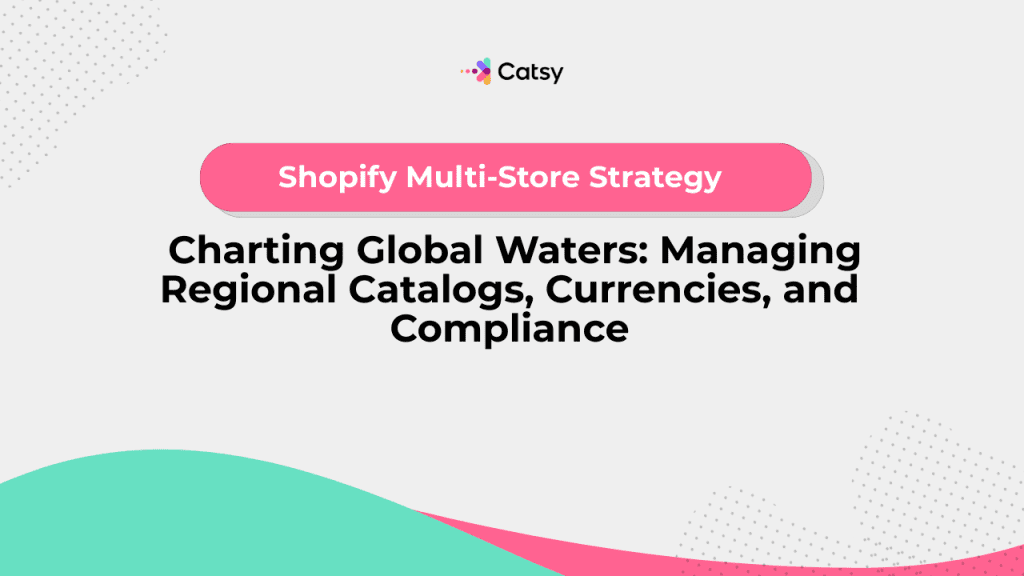Shopify Multi-Store Strategy for Charting Global Waters: Managing Regional Catalogs, Currencies, and Compliance

Navigation Chart
- Global Manufacturing E-commerce: Setting Your Course
- Regional Catalog Management: Balancing Consistency and Localization
- Currency and Compliance Framework Development
- Implementation Strategies & Real-World Success Stories
What You’ll Learn
- Strategic approaches to multi-store architecture for global manufacturing
- Regional catalog management techniques that maintain operational efficiency
- Currency and compliance frameworks that reduce legal and financial risks
- Implementation decisions that impact long-term scalability and costs
In this Article
1. Global Manufacturing E-commerce: Setting Your Course
Manufacturing companies that navigate international waters: Shopify will help you chart your course. The platform’s multi-store architecture has emerged as much more than a storefront – it’s a critical strategic decision that will affect everything from your customer experience to your regulatory compliance.
Unlike simple retail operations, manufacturers face complex challenges that may include product variations, regional certifications, and intricate supply chain logistics.
What is a Multi-Store Strategy?
A multi-store strategy involves operating separate, interconnected Shopify stores for different regions, markets, or customer segments. Operational control remains centralized.
Using this approach allows manufacturers to customize experiences for local markets while preserving the efficiency benefits of unified backend systems and processes.
Making the decision between single-store expansion and multi-store architecture isn’t just a technical consideration. It’s a strategic choice that will impact your ability to navigate diverse markets.
Many manufacturers discover that their initial approach becomes inadequate as they encounter the realities of international compliance and local market expectations.
A. Why Multi-Store Architecture Matters for Charting Manufacturing Success
Global marketing presents unique e-commerce challenges, and many standard retail solutions can’t navigate those challenges effectively. For example, an industrial buyer may expect detailed tech specs and compliance documentation. The actual requirements vary significantly across regions due to different standards, regulations, and business practices.
When you put a thoughtful multi-store strategy in place, you create the foundation for sustainable growth – internationally. Each regional store can address local compliance regulations, can display appropriate certifications, and can provide customer service in local languages and time zones.
Complex Customer Segmentation Challenges
The complexity of a global business multiplies when you consider the fact that manufacturing businesses serve both individual customers and business-to-business customers. Each has distinct requirements. A multi-store architecture lets you create experiences that are tailored to each customer type. Of course, you maintain your operational efficiency.
Taking a closer look, business-to-business buyers often require detailed tech specs, bulk pricing structures, and compliance documentation that’s quite different from consumer-focused presentations.
On the other hand, individual customers seek simplified product presentations with clear benefits, easy-to-understand specs, and streamlined purchasing processes.
As you can see, the same product requires different marketing approaches and information architecture for these two audiences.
Regional Market Variations
Manufacturing products often require different configurations, certifications, and compliance documentation – this documentation may differ across geographic regions. For instance, a European market may require CE marketing and metric measurements while a North American market needs UL certifications and imperial measurements.
Local business practices and customer expectations vary dramatically across international markets. Payment preferences, delivery expectations, and customer service requirements differ significantly between regions; this requires customized operational approaches.
Regulatory Complexity Navigation
Every market has unique regulatory requirements. These impact product presentations, safety documentation, and compliance reporting. A multi-store architecture allows for the systematic management of these – no more messy spreadsheets.
Environmental regulations, safety standards, and import requirements vary significantly across markets. Your e-commerce platform must accommodate these differences while maintaining timeliness and accuracy.
Make Catsy DAM and PIM Software an Extension of Your Team
Book a Free DemoB. Strategic Considerations for Multi-Store Planning
Scalability and Growth Planning
Your multi-store expansion must support your plans for future growth – without the need to completely restructure. Your initial design should accommodate additional regions, customer segments, and product lines as they develop.
The tech choices you make during the initial implementation of your system will impact your long-term operational costs and your scalability. Select platforms that will grow with your business to prevent expensive migrations later.
Operational Efficiency Balance
Customization allows for better customer experiences. However, complexity can overwhelm your operations. A successful multi-store strategy can balance localization needs with operational manageability.
Standardization of backend processes enables efficient operations while frontend customization serves diverse customer needs. This balance will require careful planning and systematic implementation approaches.
Resource Allocation and Management
Multi-store operations require dedicated resources for ongoing maintenance, for content management, and for customer support. Realistic planning prevents your teams from becoming overwhelmed, and it ensures sustainable growth.
On that note, team training and coordination become much more complex with multiple storefronts across different markets. Clear role definitions and communication protocols ensure your efficiency.
2. Regional Catalog Management: Balancing Consistency and Localization
Managing a regional catalog effectively means your global navigational chart is intact. This ensures consistent presentation of your brand while also accommodating local market requirements.
a. Product Variation Complexity: Managing Regional Differences
It’s rare for manufacturing businesses to sell identical products across each of their markets. This is because of varying regional requirements, standards, and even consumer preference. This complexity requires sophisticated management approaches.
Regional Safety Standards and Certifications
Different regions require specific safety certifications, testing procedures, and compliance documentation. For instance, European markets might require CE marking and EN standards compliance while North American markets need UL listings and OSHA compliance.
These certification requirements often call for actual product variations … much more than just documentation differences. Electrical products need different voltage configurations, mechanical products require different safety features, and chemical products must meet varying environmental standards.
Technical Specification Adaptations
Regional preferences for systems of measurement, tech standards, and performance specs can create a nightmare for businesses. Localized product presentations are the answer.
Performance standards and rating systems vary across regions. Energy efficiency ratings, environmental impact measures, and quality certifications will differ significantly between markets, requiring careful adaptation of technical documentation.
Material and Configuration Preferences
Your product configurations will be influenced across your markets by considerations like material preferences, climate considerations, and even usage patterns.
For example, cold climate regions might require different material specifications than tropical markets. In the same way, cultural preferences affect product features, colors, and configurations.
Understanding these preferences enables you to better position your products across diverse markets.
b. Technical Documentation Localization: Ensuring Accurate Communication
Extensive technical documentation must be accurately localized for each target market… all while maintaining technical precision and regulatory compliance.
Comprehensive Documentation Requirements
Safety data sheets, installation guides, and troubleshooting documentation are a few examples of materials that should be professionally translated and culturally adapted. Technical accuracy can’t be compromised during the localization process!
Translation Quality and Consistency
It’s not enough to rely on an AI or online translation tool. Technical translation requires specialized expertise. Technical terminology, measurement systems, and regulatory language must be precisely translated to prevent misunderstandings… or even legal trouble.
Consistency across your documentation ensures professional presentation. Standardized terminology and formatting create cohesive brand experiences across languages and regions, reducing customer confusion.
Version Control and Updates
Your technical documentation will evolve with your product improvements, regulatory changes, and compliance requirement changes. A multi-store operation needs systematic version control – current, accurate information must be visible across your regional stores.
It can be difficult to coordinate updates when you’re doing so across multiple languages and regions. Systematic processes ensure accuracy and timeliness across all markets.
c. Inventory Coordination Challenges: Managing Global Stock
Multi-store operations need to balance local inventory management with global supply chain efficiency. Meanwhile, they must also provide accurate availability information to each customer’s region.
Regional Stock Level Management
Different regions have different patterns for demand. For instance, seasonal fluctuations or supply chain characteristics can impact your optimal inventory levels. Effective coordination requires sophisticated forecasting, and allocation strategies to support this.
For example, local warehousing and fulfillment capabilities influence inventory positioning and customer service levels. In that way, regional stock positioning affects delivery times, shipping costs, and customer satisfaction.
Cross-Regional Fulfillment Strategies
Situations where products are available in some regions but not others will require intelligent fulfillment strategies. It is important to maintain customer satisfaction while optimizing operational costs.
Drop-shipping arrangements, inter-warehouse transfers, and direct manufacturer fulfillment all create complex logistics coordination requirements. These must be seamlessly integrated with customer-facing inventory info.
Real-Time Availability Coordination
Your customers expect accurate, real-time inventory information, regardless of the regional store they visit. Multi-store architecture requires sophisticated backend integration to provide this reliable availability data.
For that reason, inventory allocation strategies must balance your regional demand patterns with global supply chain efficiency. Automated allocation rules do this – they optimize your stock positioning while still maintaining service levels.
d. Pricing Structure Management: Navigating Complex Pricing Waters
Often, manufacturing products involve intricate pricing structures. These must be adapted to different regions while still keeping you profitable.
Volume-Based Pricing Across Regions
Volume discount structures might vary across regions based on local market conditions, your competition, and consumer purchasing patterns. Business-to-business customers in different regions might have different volume thresholds and discount options.
Regional purchasing power and market maturity influence pricing strategies. For example, an emerging market might require different volume-based incentives than an established one.
Customer Relationship Pricing
In many cases, your long-term partnerships will involve negotiated pricing that should be consistently managed across each region. Contract pricing, discounts for preferred customers, and other scenarios may require systematic coordination.
Implementing account-based pricing can become complex when your customers are spread across different regions. Global accounts need consistent pricing treatment while still respecting regional market conditions.
3. Currency and Compliance Framework Development
a. Multi-Currency Strategy: Managing Financial Navigation
Currency conversions are simple. In addition to these, though, manufacturers must develop sophisticated approaches to international pricing. Considerations include market positioning, competitive dynamics, and operational efficiency.
Strategic Pricing Approaches
To set international pricing effectively, you’ll need strategic positioning that reflects local market conditions – not just direct currency conversions.
Market-specific pricing strategies consider factors like local purchasing power, the competitive landscape, and the value perceived by your customer. Premium positioning in one market may translate to value positioning in another!
Currency Fluctuation Management
Manufacturing operations sometimes involve long lead times, and many have complex supply chains. These factors make currency fluctuation management critical for global profitability.
Hedging strategies, pricing adjustment mechanisms, and contract terms should be coordinated across multiple storefronts while maintaining customer transparency.
Payment Method Localization
It’s often overlooked, but different regions have different payment preferences. Banking systems and transaction processing requirements may also come into play.
Multi-store architecture must accommodate these preferences while maintaining security and a simple customer checkout process.
b. Regulatory Compliance Integration: Navigating Legal Waters
Each market has specific compliance requirements that must be systematically integrated into customer-facing experiences in an efficient, compliant way.
Product Safety and Environmental Compliance
Safety standards, environmental regulations, and import requirements vary significantly across international markets. Because of this, your multi-store architecture must present the appropriate compliance information while still ensuring accuracy.
Certification tracking, renewal management, and compliance reporting are examples that require systematic approaches. These must scale across multiple markets without creating administrative chaos.
Import Documentation and Customs Management
International manufacturing sales involve complex customs documentation, duty calculations, and import compliance requirements. These must be accurately managed across all customer touchpoints.
Automation is key! Automated documentation generation, customs classification, and even duty calculations ensure consistency and accuracy across all your customer-facing platforms.
c. Max and Duty Management: Calculating Complex International Obligations
International manufacturing sales create complex tax obligations. These, too, require systematic management across multiple jurisdictions.
Multi-Jurisdictional Tax Compliance
Different regions have varying tax structures and reporting requirements. Value-added tax, sales tax, and import duties create complex calculation requirements that must be accurately reflected in customer pricing while ensuring proper compliance reporting.
Transparent Cost Communication
Customers need to have a clear understanding of their total costs including duties, taxes, and shipping charges. Multi-store architecture must provide accurate cost information while maintaining competitive pricing presentation.
4. Implementation Strategies & Real-World Success Stories
a. Top 5 Implementation Strategies for Multi-Store Success
1. Design for Operational Efficiency First
While the customer’s experience matters significantly, manufacturers must prioritize backend operational efficiency to ensure scalability. Choose architectures that enable centralized inventory management, unified order processing, and streamlined fulfillment workflows.
Complex customer-facing features don’t mean much if they’re creating headwinds for your teams. Your successful implementation must not increase costs, nor may it introduce errors.
2. Establish Clear Content Governance
Develop effective processes for managing your data, your technical documentation, and your compliance materials across each of your stores. This may take the form of version control for technical specifications, approval workflows for regulatory content, and translation management for critical safety information.
Content governance becomes critical when multiple stores serve different markets with differing requirements. A systematic approach will prevent confusion and ensure accuracy across each of your customer touchpoints.
3. Plan Integration Architecture Carefully
A multi-store setup should integrate seamlessly with your legacy systems, including customer service, ERP, and others. Poor integration creates silos and can increase your cost and potential for errors.
Integration planning should consider current systems, future requirements, and scalability needs. A well-designed integration will enable operational efficiency while supporting the growth of your business.
4. Build Scalable Compliance Frameworks
Instead of handling compliance requirements ad-hoc, develop systematic approaches that can accommodate your plans to scale.
This may include templates for common compliance documentation, standardized processes for regulatory approvals, and scalable systems for managing market-specific requirements.
A scalable compliance framework enables rapid market entry while maintaining operational efficiency and compliance.
5. Optimize for Long-Term Maintenance
Multi-store operations require ongoing maintenance, particularly as you grow. Chart your approach with realistic expectations for long-term management. Consider staff training, system updates, and processes for adding new markets or product lines.
b. Real-World Multi-Store Implementation Examples
Industrial Equipment Manufacturer’s European Expansion
A US-based equipment manufacturer needed to sell across European markets with different electrical standards, safety certifications, and language requirements.
Their multi-store approach created region-specific catalogs that featured appropriate product variants. Localized technical documentation and compliance certificates were generated for each.
This strategy enabled the company to need strict European standards while still maintaining their own efficiency. Centralized inventory management coordinated with regional compliance requirements. This created seamless customer experiences.
The implementation also resulted in 40 percent faster entry into European markets compared to manual processes. Customer satisfaction improved significantly due to accurate product presentations and compliance documentation.
Precision Components Global Strategy
A precision manufacturing company served both OEM and aftermarket buyers. They implemented separate stores for each customer type and region. Each store now features appropriate pricing structures and ordering processes… all while sharing backend inventory and fulfillment systems!
As you’d imagine, this approach improved customer experience while reducing the complexity of backend operations. Business-to-business consumers received bulk discounts and detailed specs, while DIY-ers enjoyed simplified information and retail pricing.
The segmented approach increased average order values by 25 percent through better customer targeting and appropriate product presentations for different audience types.
Chemical Products Compliance Solution
A specialty chemical manufacturer created stores that were region-specific. These unique storefronts handled varying hazmat regulations, shipping restrictions, and safety documentation.
Automated compliance documentation ensured regulatory accuracy, while streamlining order processing in the process. Regional stores displayed appropriate safety warnings, handling procedures, and regulatory information without manual coordination requirements.
The systematic approach reduced compliance-related customer service inquiries by 60 percent while ensuring accuracy across all international markets.
c. Working with Multi-Store Implementation Navigators
Implementing Shopify for multiple stores requires expertise spanning e-commerce tech, international business practices, and manufacturing operations.
The complexity of these considerations often exceeds internal capabilities, particularly for companies focused on manufacturing rather than e-commerce technology.
Selecting Implementation Partners
Experienced implementation specialists understand these challenges. They can identify pitfalls that may arise, then may recommend proven approaches to avoid them. If complexities do arise, they can help navigate them and coordinate them with your legacy systems.
As you “shop” for a partner, prioritize the ones with demonstrated experience in manufacturing e-commerce, international compliance, and complex integrations.
Ongoing Support and Optimization
Multi-store operations require ongoing effort! An implementation partner should provide you with ongoing assistance, whether that be system updates, new market expansions, or general operational optimization.
Key Takeaways
- Multi-store architecture enables manufacturers to address regional requirements while still maintaining operational efficiency across global operations.
- Success requires careful planning of backend integrations, comprehensive content governance, and scalable compliance frameworks.
- Regional customization must balance local market needs with global operational consistency to ensure sustainable growth.
- Implementation complexity demands realistic assessment of long-term maintenance requirements and resource allocation needs.
- Professional expertise is often essential for navigating technical complexities and avoiding costly implementation mistakes.
Want more tips, tutorials, and insights on product content and e-commerce operations?
Stay connected. We post regularly to help brands like yours scale smarter.
Are You Ready To streamline your product content management?

Frequently Asked Questions
Consider multi-store architecture when you are facing significant regional product variations. Complex compliance requirements and distinct customer segments should also be considered.
Typically, manufacturing businesses will benefit from multi-store approaches. This is especially true if you’re serving markets with different safety standards or regulatory requirements. Remember, too, that business-to-business and business-to-consumer customers will have fundamentally different purchasing processes.
Effective inventory management requires integration between your stores and your legacy systems. This usually involves middleware solutions.
You can synchronize your stock levels, coordinate fulfillment, and manage your regional allocation strategies. The key lies in maintaining real-time visibility across each of your channels while enabling flexible fulfillment.
The primary challenges you may face include management of safety standards, tech documentation, and environmental regulations. Proper customs and import documentation may also come into pay.
Each market may require different certifications, testing procedures, and ongoing compliance monitoring, and these must be integrated into your multi-store operations.
Focus on standardizing your backend processes while customizing your customer-facing elements.
Invest in robust platforms and include clear operational procedures. The goal is to present localized experiences to your customers while still keeping your internal operations as streamlined as possible.
Critical integrations to consider include your ERP systems, your CRM platforms, and your compliance management systems. Regulatory tracking and tax management should be included as well. These will ensure operational efficiency while also supporting diverse global requirements.
You’ll need centralized support with regional expertise. Knowledge bases should be localized but consistent in resolution approaches. Don’t forget to consider time zone coverage and local business practice awareness.
Regular maintenance includes content updates across each of your stores, compliance monitoring, system integration maintenance, performance optimization, and staff training. Plan to have dedicated resources for these aspects of your implementation.
You can track region-specific metrics, then compare them across regions. Consider conversion rates, average order value, customer acquisition costs, and customer satisfaction. Account for local market conditions, and consider business maturity. Unified reporting systems help identify optimization opportunities and successful strategies that can be replicated across regions.
Chart your course toward global manufacturing success with strategic multi-store architecture that serves diverse markets while maintaining operational excellence. With proper planning and implementation, your Shopify multi-store strategy will navigate international waters with confidence and efficiency.
Subscribe For More Content
Sign up for monthly tips on how to drive revenue with product content.




